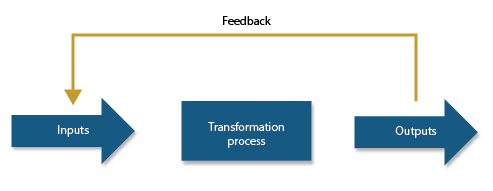2 Transformation model
In Session 3 you were introduced to the idea that business is a value delivery system with both inputs and outputs. However, as enterprises attend ever more closely to the customers, it is important not to forget the bit between the big idea and someone actually using it. You might call this transformation, production or operations.
In this simplified model, inputs fall into three main types:
- materials, or the physical things you might turn from one state into another
- information, which is part of the process or transformed through the process
- people, who through engagement are transformed in some way.
Here transformation is not just turning raw material into something else. It also involves the transformation of information (e.g. an accountant turning receipts and invoices into financial statements) or the transformation of people (e.g. a personal trainer making you fitter). In this middle stage, the transformation process involves the configuration of:
- facilities, such as land, premises, machines or other equipment
- people, such as staff or contractors directly involved in the transformation process.
Through the organisation of inputs and the alignment of resources into capabilities within a transformation process, you then get some kind of output.
Next you will look at the different types of transformation processes that can occur.

